How to Make Kombucha with simple ingredients from scratch. This kombucha recipe is easy if you follow our quick video instructions. And costs 30 times less than store bought!
We will show you how to grow a SCOBY (you can also buy one or get from a friend), brew kombucha and then even make it fizzy. This is a full guide to homemade kombucha tea that costs 30 times less than store-bought. Aha, that’s right!
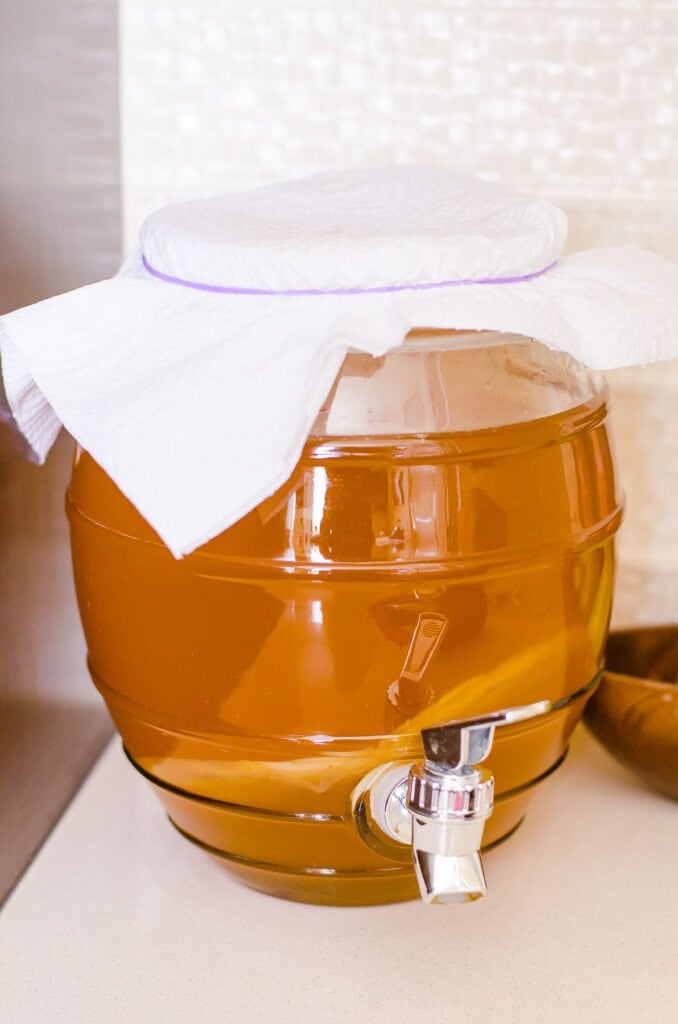
Table of contents
Why Make Homemade Kombucha?
Wondering why and how to make kombucha at home? Got “a kombucha problem” and don’t like how much it costs? I don’t blame you. Store bought kombucha costs as much as wine.
1 gallon kombucha = $28 Store bought vs. $0.80 Homemade = 30 times cheaper
Shocked? I was too. This reason alone should be enough to get over any aversion towards kombucha SCOBY, the jellyfish like slimy kombucha “mushroom”, and learn how to make your own kombucha.
I have been making my own kombucha for 5 years now. Making kombucha at home is super-super simple once you understand how kombucha tea brewing process works. This post goes into detailed instructions including a video, supplies needed (with affiliate Amazon links I use and trust myself) and a huge section of FAQs. Keep scrolling below or click on any link in the Table of Contents above for a quick jump to your section of interest.
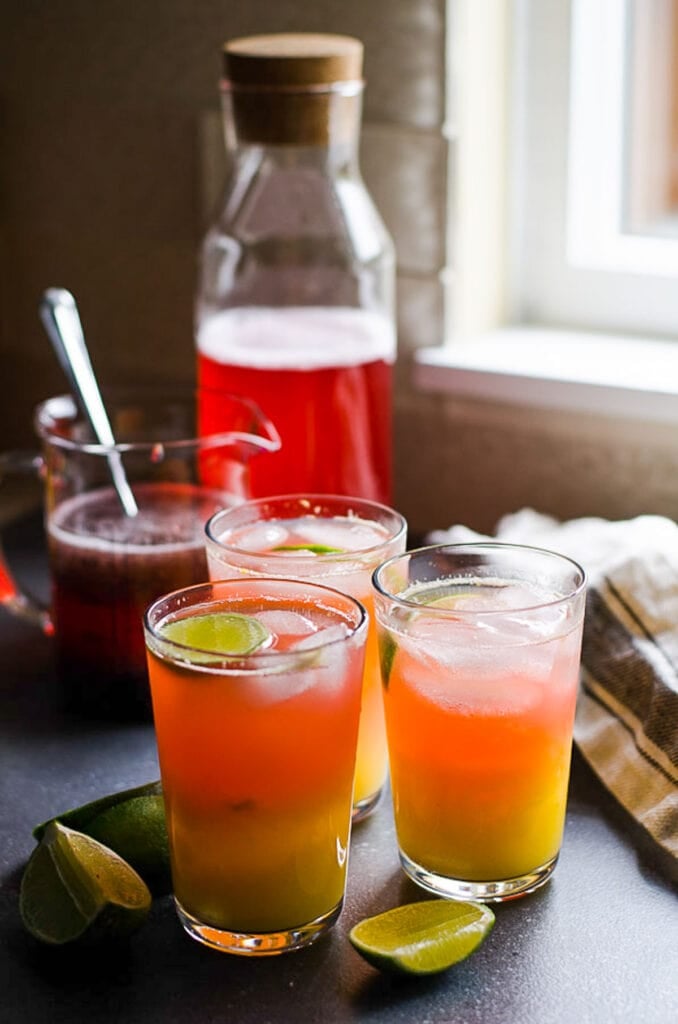
What Is a Kombucha Tea?
Kombucha tea is a fermented tea made with water, tea, sugar, bacteria and yeast. After kombucha SCOBY (mushroom) sits in a sweetened tea for 7-10 days, the result is barely sweet fermented fizzy drink. Most sugar in store bought kombucha comes from added sugar.Kombucha definitely tastes and smells like a fermented product. Something in between apple cider and tea. It tastes depends on type of tea leaves used and flavorings added. There is a big difference in taste between green tea and black tea fermented tea.
Ingredients and Supplies You Will Need
Ingredients
- Kombucha SCOBY: You will need to grow your own SCOBY first from a mix of a bottle of store-bought kombucha, tea, sugar and water. However, you can buy fresh SCOBY with starter tea to speed up the process by 2-3 weeks or get one form a friend.
- Tea: Any caffeinated, flavoured (love Earl Grey tea here) or plain tea like white tea, black tea or green tea works. No decaf tea. You can also use tea bags (I list the amount in the recipe card below).
- Sugar: White or cane sugar, preferably organic. No brown, coconut or raw sugar. Also no honey, maple syrup, stevia, splenda etc.
- Water: Can be just tap cold water, doesn’t have to be filtered.
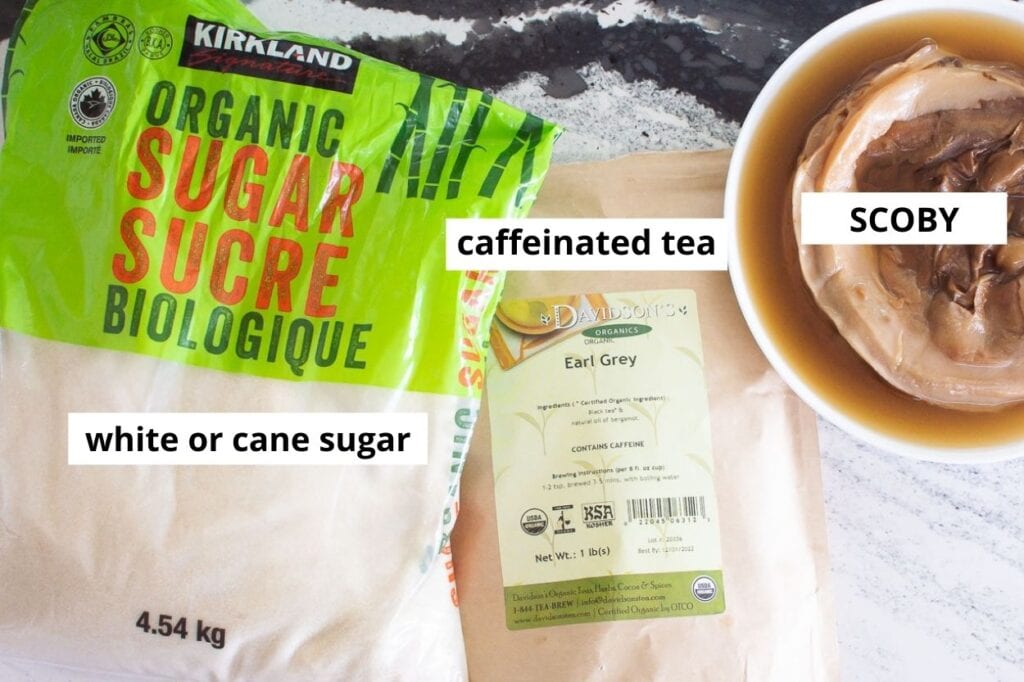
Supplies
- Large glass container: Has to be glass or ceramic minimum 1 gallon size. I always use a glass dispenser with a plastic spout (which is fine!) that makes pouring the brewed kombucha so much easier.
- Flip top glass bottles: Airtight bottles will keep carbonation in.
- Fine mesh sieve: Filters out large and small loose leaf tea leaves making your drink super clear.
- Linen or paper towel and a rubber band: You want to allow air to circulate during the fermentation process.
Bottles cleaning tip: With time inside of the bottles accumulate a tea build up. Add 1 tsp baking soda and 1 tbsp uncooked rice, then fill up with hot water half way. Shake, let stand fo 10 minutes, shake well again and rinse. Bottles should be much cleaner now.
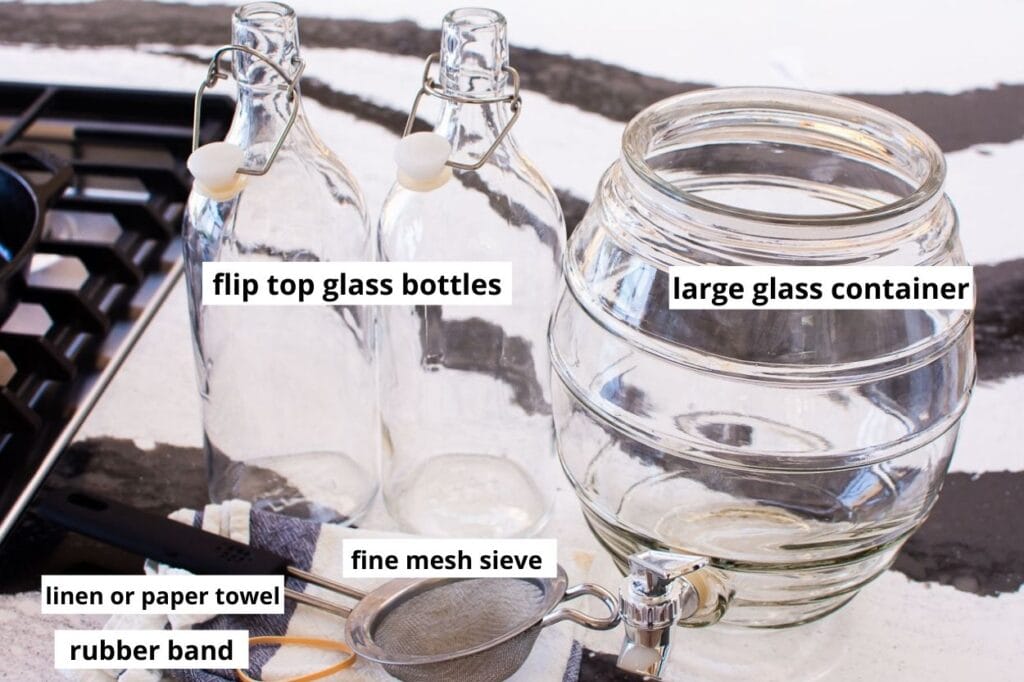
How to Make Kombucha from Scratch
Here is a quick recap of the whole process:
- Grow or buy a SCOBY
- First fermentation – brewing kombucha.
- Second fermentation (optional) – flavoring and making kombucha more fizzy.
1. Grow or Buy Fresh SCOBY with Starter Tea
Here is a super easy video recipe how to grow kombucha SCOBY. Quick recap: All you will need is a bottle of store-bought kombucha, combined with a few cups of homemade sweet tea and left to ferment for about 2 weeks or until a SCOBY forms on top. Or you can buy fresh SCOBY with starter tea these days. Amazing!
You might be able to grow a SCOBY with store-bought flavoured kombucha. Just make sure it contains black tea. For example, I think ginger kombucha will have more chances than mango one.
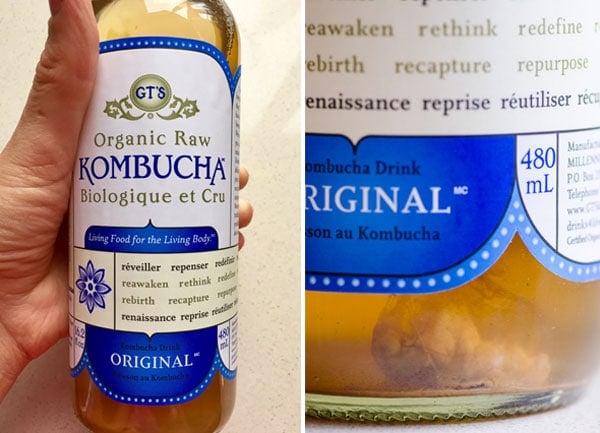
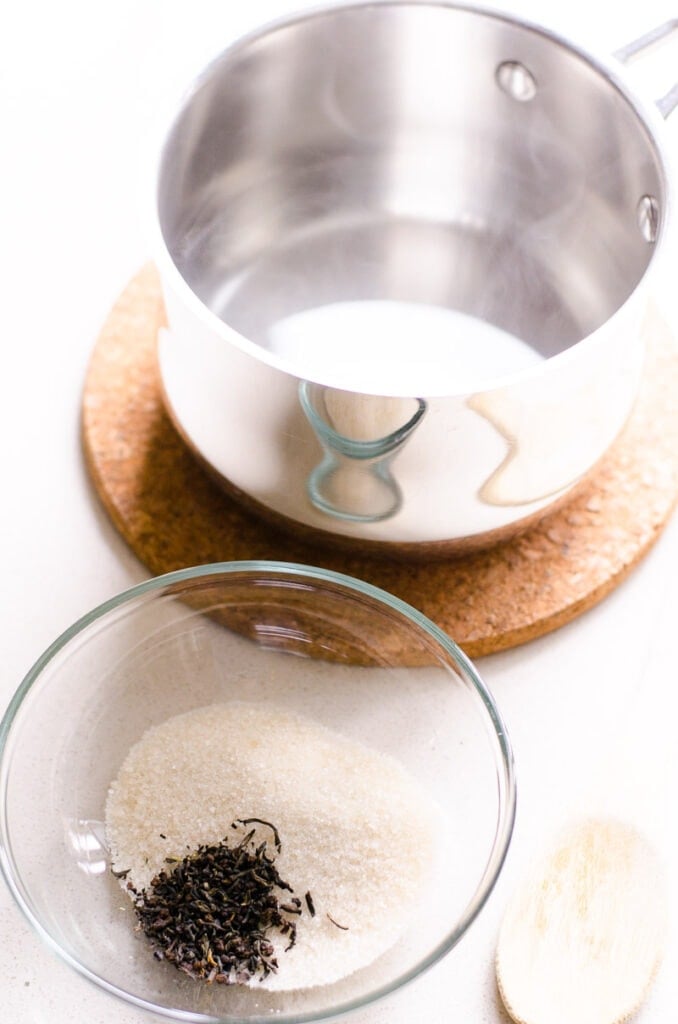
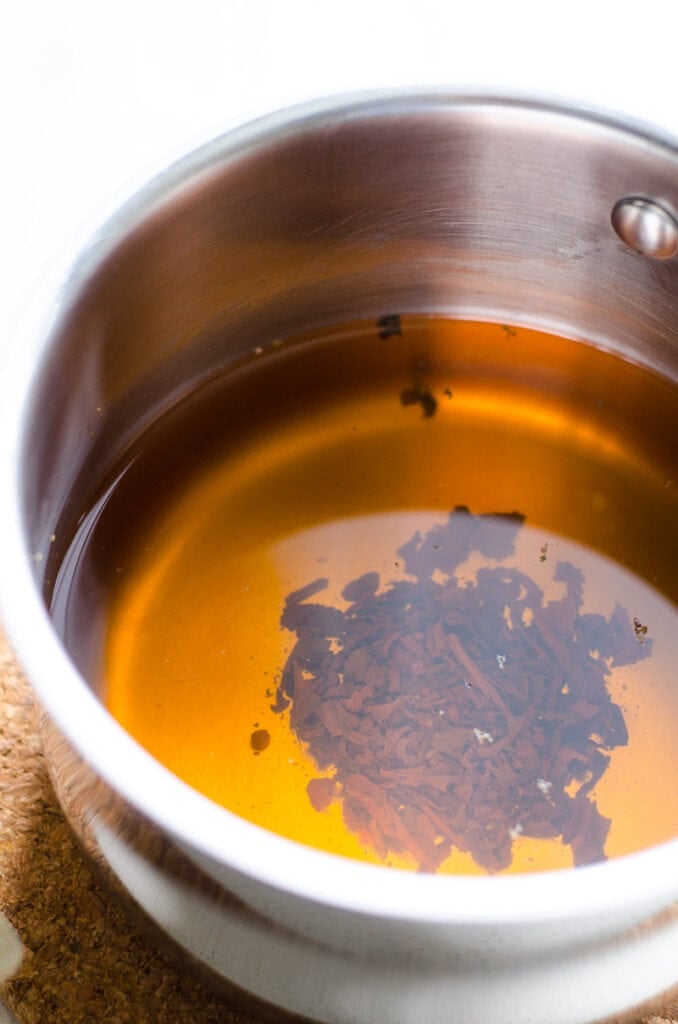

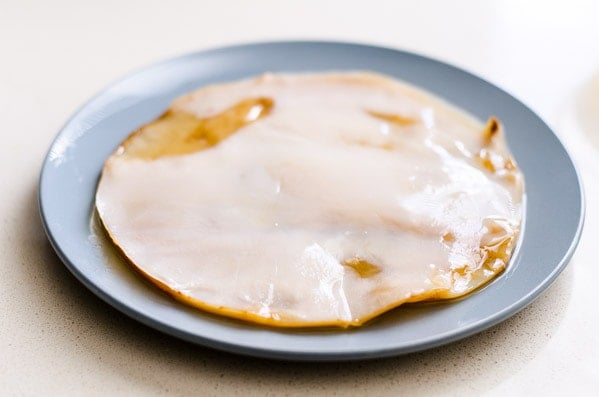
2. Brew Sweet Tea
Now that we have kombucha mushroom, we are ready to brew kombucha also called “first fermentation”. In a large pot, bring water to boil and turn off heat. Add tea leaves and sugar, stir and let cool completely.
To speed up the cooling process, place pot in a sink filled with cold water for 30 minutes, or let cool outside (if it’s cold). I use the same pot each time when making kombucha, so now I do not have to measure 14 cups of water every time.
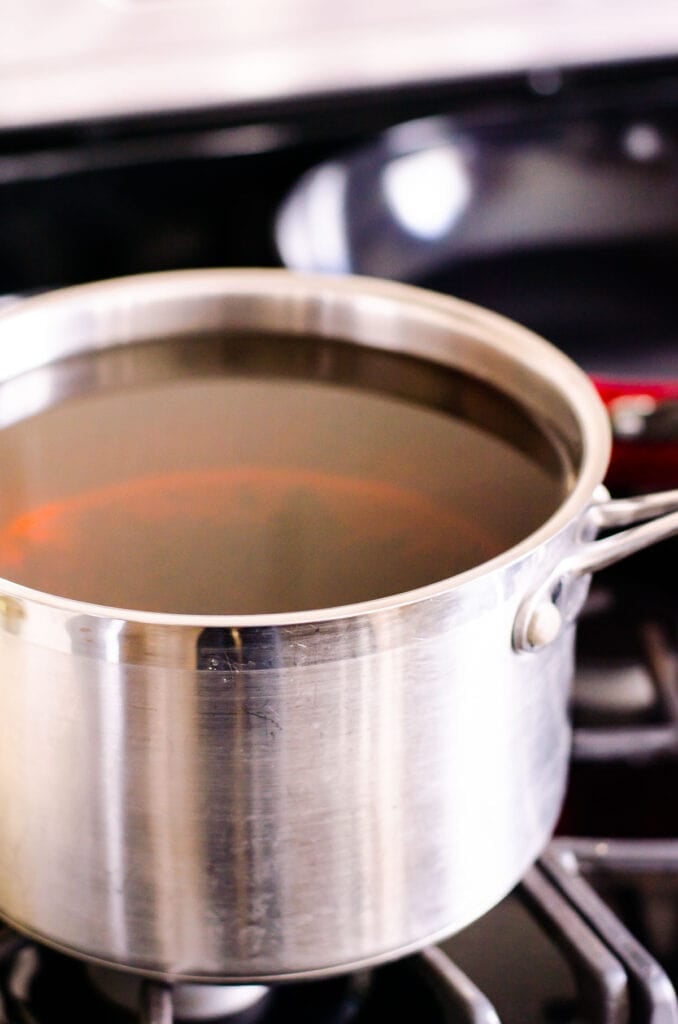
3. Combine Tea and SCOBY
In at least one gallon size glass beverage dispenser, add SCOBY and 2 cups of starter tea (the one from growing a mushroom in or store-bought kombucha). Pour cooled tea on top using a fine mesh strainer.
Once you pour freshly brewed tea, it is normal to see the SCOBY sink to the bottom or hang sideways. It will float to the top after a few days of fermentation.

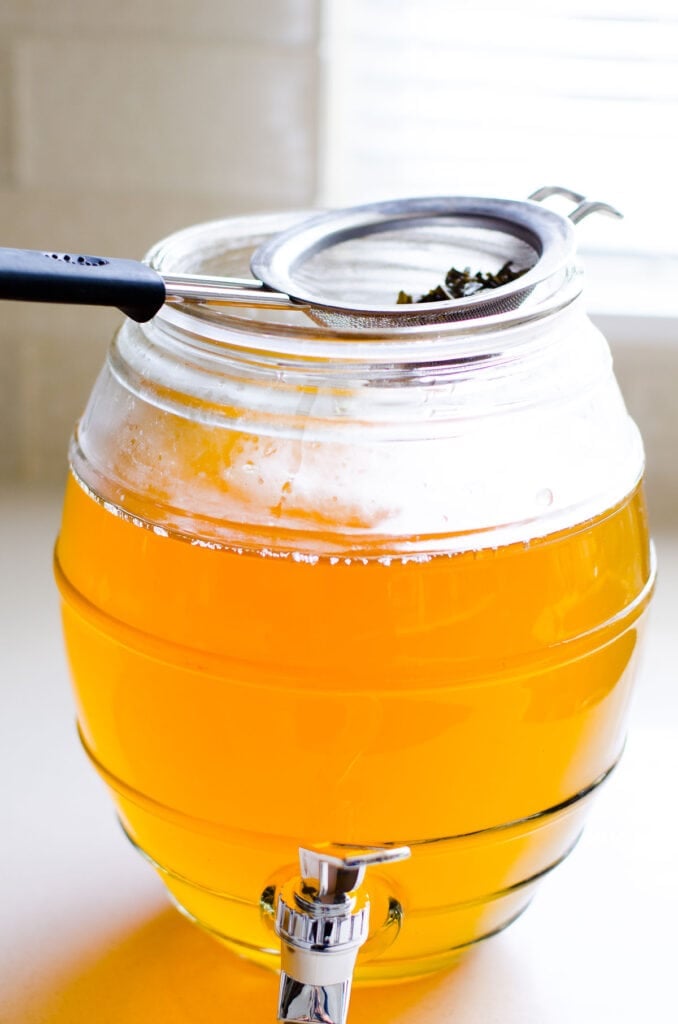

4. Ferment
Cover with paper or linen towel secured with a rubber band and put in a place with temperatures around or above 21C or 70F degrees (I leave mine on a kitchen counter away from direct sunlight) to ferment for 7-14 days.
How do I know my kombucha is brewing? Kombucha will lighten in colour and develop fermented smell. You will also see small bubbles forming and new SCOBY forming on top of the first one.
In summer, warmer temperatures speed up the fermentation. And in winter, they slow it down. Keep an eye on the kombucha based on the season and your house temperatures.
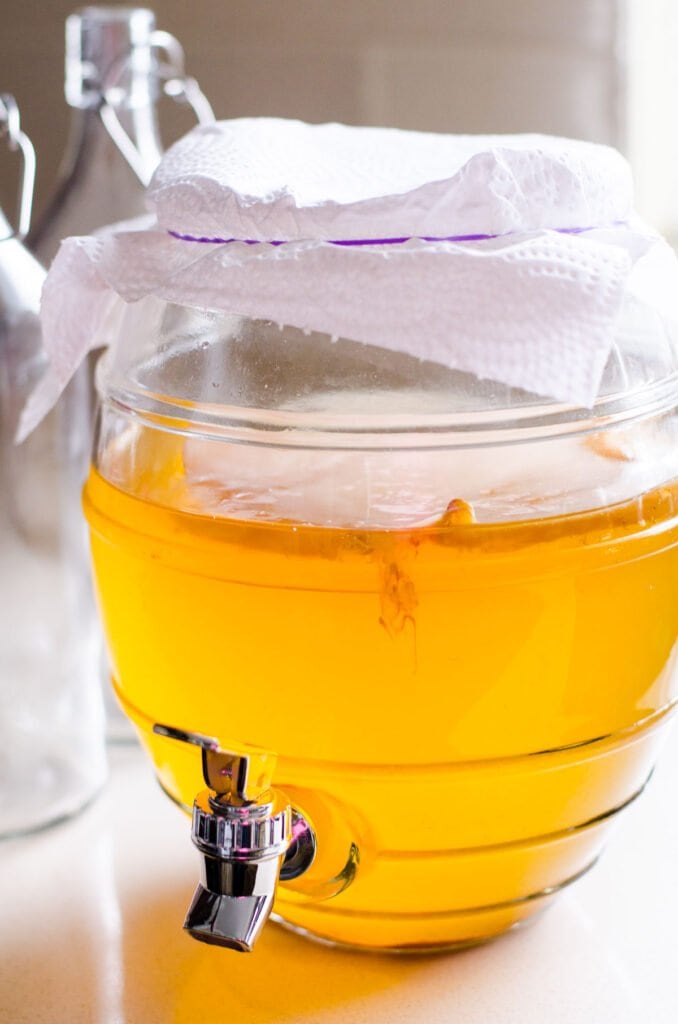
5. Taste and Bottle
After 7-10 days (less in summer) start tasting kombucha. If it isn’t sweet, has a tangy taste, fizzes as you pour and booch mushroom is floating at the top, then your fermented tea is ready. Pour all of it, minus the 2 cups and SCOBY, using a funnel into an airtight cap bottles and enjoy!
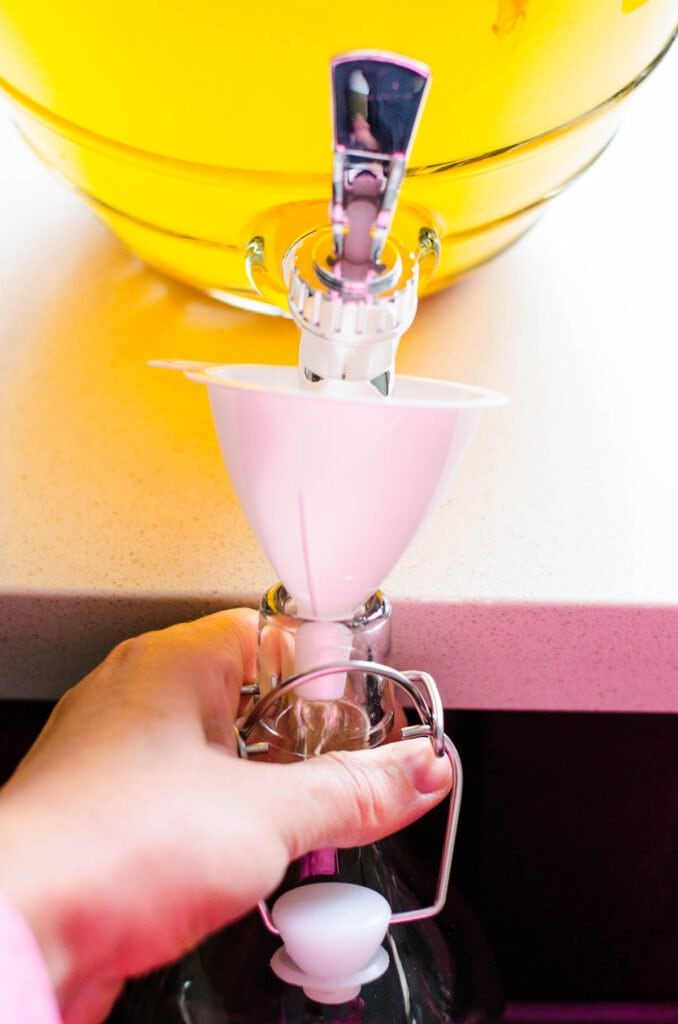
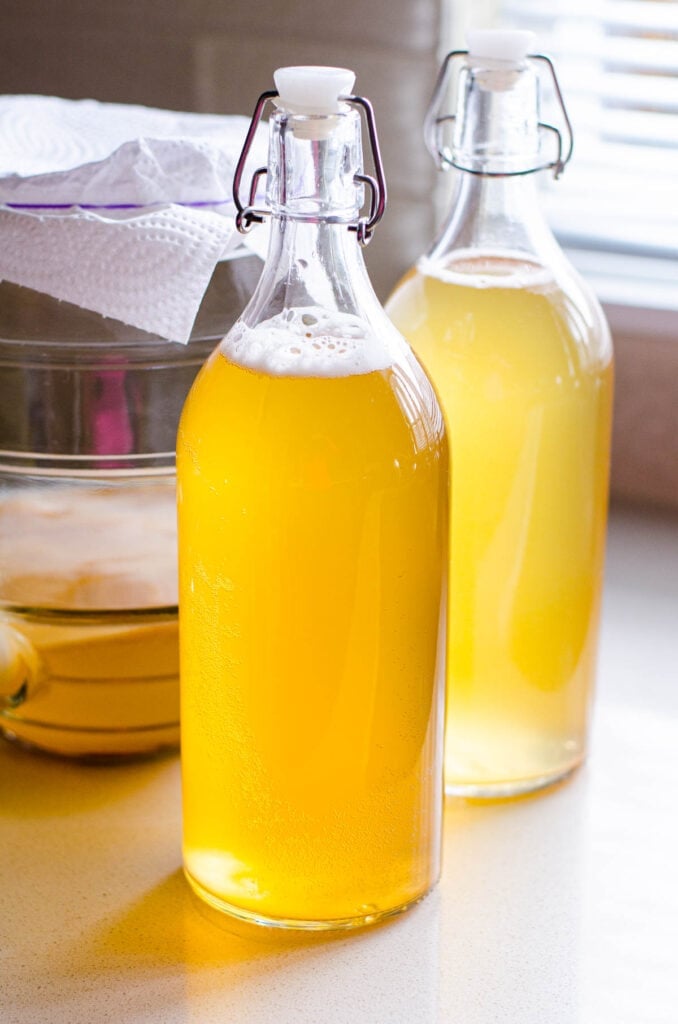
6. Storing Kombucha Tea
Does kombucha go bad? Kombucha tea doesn’t go bad but rather keeps fermenting which makes it taste more vinegar-y. Choice of storage depends on your personal taste buds. Keep at room temperature for up to one week, “burping” bottles every few days to avoid gases build up. After that (or from the start) refrigerate for up to 2-3 weeks. Fermented tea loses its carbonation when refrigerated and doesn’t need “burping”.
There is nothing like freshly brewed kombucha. When it’s ready for bottling, I like to pour myself a big glass directly from the dispenser with a spout before bottling the rest up.
7. Repeat
Always leave about 2 cups of fermented tea covering the SCOBY in a jug, to keep it hydrated and to be able to start a new batch. To brew next batch, start with step 2 by brewing and cooling the sweet tea.
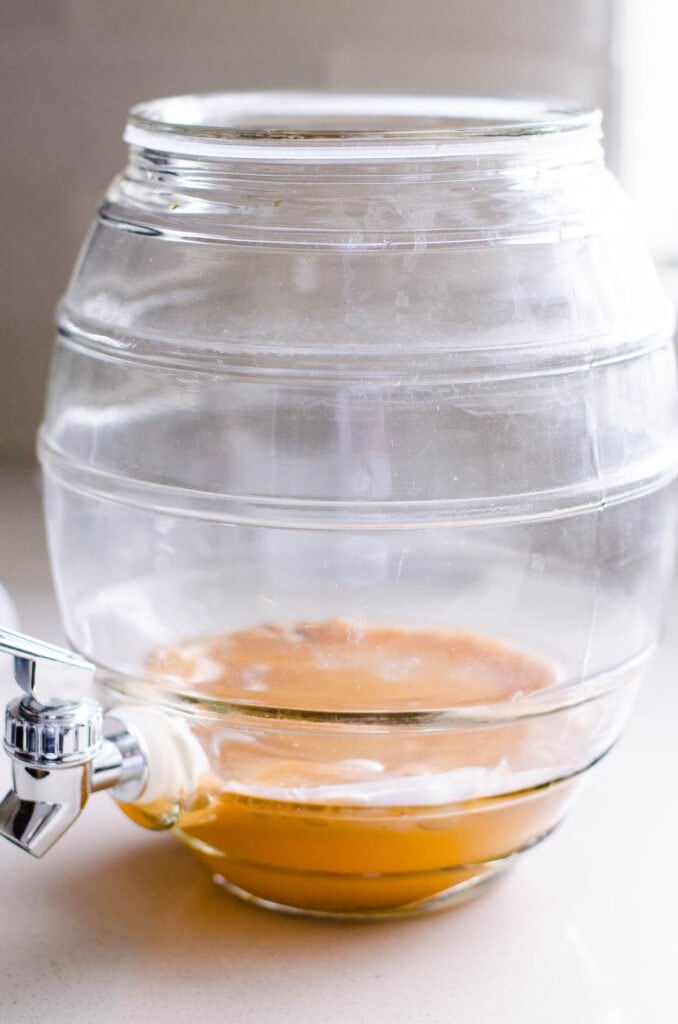
Health Benefits of Fermented Tea
One word – PROBIOTICS. Kombucha is a fermented product containing the “good” bacteria.
- Stronger immune system.
- Improved digestion.
- Healthy gut.
- Detoxification.
If you are looking for another way to boost your immune system, detoxify and improve gut health, check out how to make lemon water.
How to Flavor and Make Kombucha More Fizzy
Freshly poured kombucha tea from the dispenser with a SCOBY is very fizzy. It loses its carbonation once bottled, especially in a fridge. Would you like it to be more fizzy? Then you need to do a second fermentation aka how to make kombucha fizzy.
Would you like your kids to drink and love the booch? Would you like to make your own “healthy pop”? Then click and learn everything about flavoring kombucha.

Homemade Kombucha FAQs
Unfortunately not. Kombucha is one of few recipes where you have to use white or cane sugar. Raw sugar, coconut sugar, honey, maple syrup, stevia or any other sweetener will not work. However, you will not be eating 1 cup sugar once tea has fermented. The sugar acts like the food for the bacteria and yeast. They will eat it all up turning into acidity and carbonation. Final kombucha is very low in sugar.
No, caffeine is a must for the fermentation process to occur. You can combine a bit of flavored tea with black or green or white tea to add flavor.
No and yes. I don’t rinse the mushroom but if you want to – go for it. Every few batches I wash the jug with biodegradable dish soap (check out the non-toxic cleaners I use). I have read that you should wash jar with vinegar but because I don’t use conventional harsh dish soap, I am not too scared of the chemicals making my SCOBY “sick”.
I honestly never had this issue. Neither any reader has reported it. So it is very rare and what you might think is a mold, is actually new SCOBY growing on top. But if it happens, you have to discard the entire batch and start over again.
That is a new SCOBY growing – “a baby”.
Always leave the top (newer) kombucha mushroom to keep brewing kombucha. Peel off the older one and you have 2 options:
Option #1: Give it to friends or start another batch.
Option #2: Compost it. It sucks, it’s a waste but at least it gets composted.
Yes, SCOBY is easy to cut with a pair of clean kitchen scissors. In fact, you always should keep only a few SCOBies in your kombucha brewing batch because too many and your fermented tea will be sour. Think of it as a bigger hungry “baby” that will eat sugar faster. However, you should also keep in mind that for best carbonation results the shape of a SCOBY should be the shape of the jar creating a tight seal.
Yes, technically. I have seen scoby candy recipes and have heard some folks feeding the mushroom to their dog.
To maintain a bit of a fizz, store kombucha at room temperature (not refrigerated) in an airtight bottle. Carbonation won’t be as strong but still some is better than none.
When we went on vacation to Mexico for a month, I placed the jug with SCOBY and about few cups of kombucha in the fridge for 4 weeks. This way the fermentation process slows down. If I want to take a break for a shorter period of time while at home, let’s say 7-10 days, I just let the jar sit on a counter in the same way.
Yes, a bit. It contains approximately 1/3 the amount of caffeine as the tea it is made with.
Alcohol level in kombucha is 0.5% ABV compared to 5% ABV in beer. Definitely won’t make you drunk.
Drink as much as desired. There is no right or wrong formula for health benefits. Make sure to drink plenty of water as kombucha is natural detoxifier. And you want to flush the newly released toxins out.
Yes for sure. My kids love the booch, especially the flavored one. They treat it as pop or juice.
You let it ferment too long. Happens to the best of us. I usually make a few cups of strong sweet tea, let cool and add to the jug with the booch. Let sit for another 1-2 days, taste and bottle. Do not add sugar directly to the jug with kombucha as it will not dissolve or help with the acidity.
Black tea. Its leaves that have been oxidized for a long time creating a bold flavor.
Choice of storage depends on your personal taste buds. Keep at room temperature for up to one week, “burping” bottles every few days to avoid gases build up. After that (or from the start) refrigerate for up to 2-3 weeks. Fermented tea loses its carbonation when refrigerated and doesn’t need “burping”.
More Healthy Drinks Recipes
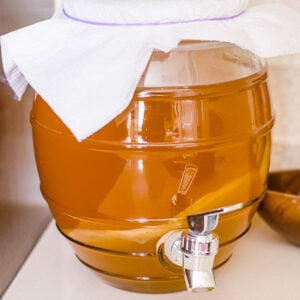
How to Make Kombucha
Ingredients
- 1 kombucha SCOBY
- 2 cups previously brewed kombucha from a jar with SCOBY or store-bought
- 14 cups water
- 1 cup white or cane sugar not honey, stevia, raw or coconut sugar
- 2 tbsp loose leaf black or green tea or 8 tea bags
Instructions
- Make kombucha SCOBY. All you will need is a bottle of store-bought kombucha, combined with a few cups of homemade sweet tea and left to ferment for about 2 weeks or until a SCOBY forms on top. Or you can buy fresh SCOBY with starter tea these days.
- In a large pot, bring water to boil and turn off heat. Add tea and sugar, stir and let cool completely: place in a sink filled with cold water to speed things up, or let sit overnight.
- In a glass container, add SCOBY and 2 cups of starter tea (the one from growing a SCOBY in or store-bought kombucha). Pour cooled tea on top using a fine mesh strainer.
- Cover with paper or linen towel secured with a rubber band and put in a place with temperatures around or above 21C or 70F degrees (I leave mine on a kitchen counter away from direct sunlight) to ferment for 7-14 days. It is OK if SCOBY isn’t floating at the top (it will later).
- After 7-10 days (less in summer) start tasting kombucha. If it isn’t sweet, has a tangy taste, fizzes as you pour and SCOBY is floating at the top, then your kombucha is ready.
- Pour all of the kombucha, minus the 2 cups and SCOBY, using a funnel into an airtight cap bottles and enjoy!
- Always leave about 2 cups of fermented tea covering the SCOBY in a jug, to keep it hydrated and to be able to start a new batch. To brew next batch, start with step 2 by brewing and cooling the sweet tea.
Video
Notes
- Store: Kombucha tea doesn’t go bad but rather keeps fermenting which makes it taste more vinegar-y. Choice of storage depends on your personal taste buds. Keep at room temperature for up to one week, “burping” bottles every few days to avoid gases build up. After that (or from the start) refrigerate for up to 2-3 weeks. Kombucha loses its carbonation when refrigerated and doesn’t need “burping”.
- Plastic spout: If you have glass dispenser with a tap and it is plastic, know it is fine and normal. That is what I have.
- Can I use plastic or metal container for making kombucha? No, it has to be glass.
- What is best tea for making kombucha? Any caffeinated, flavoured or plain tea like white tea, black tea or green tea works.
- What is ideal room temperature for brewing kombucha? About 68 – 70 F or 20-21 C for bacteria to grow and kombucha ferment. Warmer temperature means faster fermentation.
- Can I take a break from brewing kombucha? Yes. When we went on vacation to Mexico for a month, I placed the jug with SCOBY and about few cups of kombucha in the fridge for 4 weeks. This way the fermentation process slows down. If I want to take a break for a shorter period of time while at home, let’s say 7-10 days, I just let the jar sit on a counter in the same way.


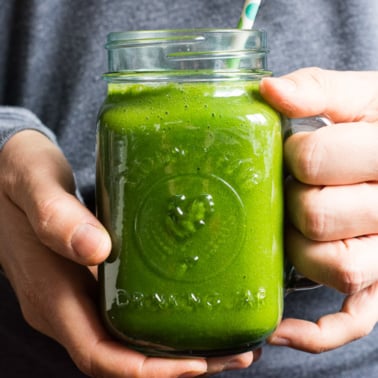
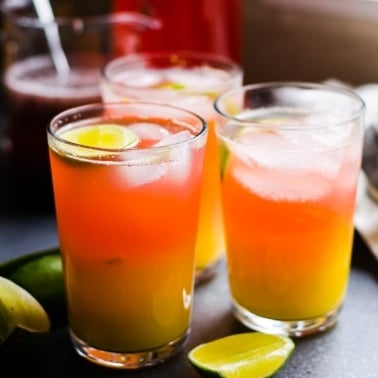
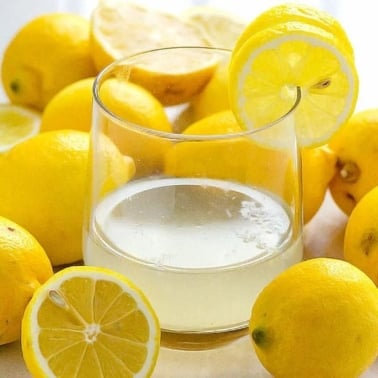









Thanks for sharing! Lots of wonderful tips 🙂
Do you keep the jars on the counter when doing a continuous brew? or does it need to be in the dark?
If I understand correctly you add more sweet tea (to the booch that is leftover) and starter tea to the jar and scoby when it starts getting low, correct?
Just away from direct sunlight is fine. In the counter was in my old house. Now I have dark room pantry. Doesn’t matter.
Yes. You bottle kombucha and leave some in the jug with scoby and pour fresh batch of sweet tea.
Hi and felicitation for your site.
My situation,
I just boil my tea and brown sugar in a container from Starfrit the Rock . The one who are copper color with the small white dots.
It’s ok ?
Does the boiling need to be in a stainless container as a absolute ?
Thanks for your time !
Michael
Pot is fine. Not sure about brown sugar though as it has molasses but see what happens I guess.
Thank you ever so for you blog post. Awesome.
This article was very helpful, thank you!
I left a jar of apple cider vinegar for a couple months and it grew what looks like a Scoby. Can I use that to make my own kombucha? And if I do, can I just put it in the jar with tea, sugar and water? Do I have to add already made kombucha?
Hi Gabby! I have never grown a scoby from apple cider vinegar. Looks like others on the web have, so you might want to follow their instructions.
Thank you for this recipe. I would like to try it, but I’m moving next month. Do you have any tips for flying with scoby?
Flying with a scoby lol. Yes, totally fine if it’s covered with kombucha liquid and in a tightly sealed container like a jar. Happy moving!
I have a quick question regarding the final nutrition facts for this recipe — specifically the sugar content. For 14 cups of water, you added 1 cup of sugar (200g). 200g divided by 14 cups of water equates to 14.3g per serving. Does the yeast really convert all the way down to 2g per cup, and how can you tell/measure? My goal is to make a healthy beverage that is low in sugar, but I’m having difficulty determining the sugar content of my second ferment, even when using a refractometer and hydrometer — the readings seem to be wildly inconsistent.
Thanks in advance for your help!
-H
Nutritional info is provided as a guidance. It is hard to tell how much sugar is left in kombucha because bacteria feeds off of it.
Can you make kombucha without putting original flavor kombucha?
I am not sure I understand your Q. You mean flavored kombucha or no kombucha at all?
Hi, just got my live scoby from amazon packed in a plastic bag. Kept in the fridge and started reading recipes. There is no starter tea. Do you think I can start my kombucha following all steps: brew black tea ,add sugar add scoby, but without previously brewed kombucha tea?
Unfortunately not. I would buy a bottle of kombucha and add in there.
the liquid in the bag with your scoby will be enough
Can you use stevia instead of sugar?
No. Sugar is necessary for fermentation to occur.
If room temperature is consistently below 21C, will (first) fermentation not occur, or just slow down and take longer? Will leaving it longer increase risk of mould?
Hi David. Cooler temperatures mean that fermentation will take longer. I haven’t had any issues with mold. Hope that helps.
Thanks for that… follow up question… Is fermentation time dependant on batch size (Eg. Is a small batch quicker), or is this irrelevant if the Scoby size is proportionate to the batch size?
Correct. Size of scoby matters, so larger quantity will brew slower with smaller scoby and vice versa.